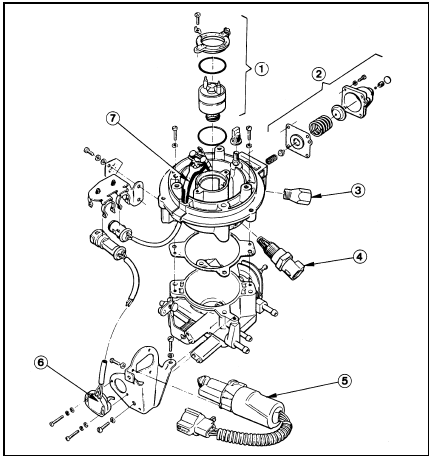General information and precautions
General information The system is best described by dividing it into four separate sub-systems: air, fuel, engine management (EEC IV system), and ignition.
Air system
The air system consists of an air cleaner,
connecting air inlet duct, CFI unit, MAP
(Manifold Absolute Pressure) sensor, and inlet
manifold.
Air is drawn through the air cleaner and inlet duct to the CFI unit. The CFI unit contains an ACT (Air Charge Temperature) sensor and a throttle valve (see illustration).

1.2 Exploded view of the Central Fuel Injection (CFI) unit - 1.4 CFI engine
1 Fuel injector assembly
2 Fuel pressure regulator components
3 Fuel inlet connector
4 Air charge temperature (ACT) sensor
5 Throttle valve control motor
6 Throttle position sensor (TPS)
7 Fuel injector wiring
The ACT
sensor passes information to the EEC IV
module, which uses the information to
determine the engine’s fuel requirement. The
inlet air then passes the throttle valve into the
inlet manifold. Below the throttle valve is a
take-off point for the MAP sensor which
measures pressure in the manifold, passing
this information to the EEC IV module. The
EEC IV module uses this information as
another factor in determining fuel
requirements and ignition timing at full throttle
or during ignition key “on” engine “off”
conditions. Using the information from the
ACT and MAP sensors, the EEC IV module
can calculate the mass of air entering the
engine and adjust the fuelling and ignition
timing accordingly.
Fuel system
The fuel system consists of a fuel pump,
fuel filter, and the CFI unit. Power to the
system is supplied by the power relay, which
has a built-in timer which allows the throttle
valve motor to continue to operate after the
engine is switched off, preventing the engine
from “running on”.
The fuel pump is electric, of roller cell design, and delivers fuel under pressure to the engine. Electric power to the pump is supplied via a relay which is controlled directly by the EEC IV module. The pump contains a nonreturn valve which maintains pressure in the system after the ignition is switched off, to assist starting.
From the fuel pump, the fuel passes through an in-line filter to the CFI unit. A fuel pressure regulator, mounted on the CFI unit maintains fuel pressure to the injector at 1 bar.
Excess fuel is returned to the fuel tank.
The CFI unit, resembling a carburettor, houses the throttle valve, throttle valve control motor, TPS (Throttle Position Sensor), ACT sensor, electronic injector unit, and pressure regulator.
Engine management and emission
system
The EEC IV (Electronic Engine Control IV)
module is a microprocessor-based system
containing within its memory the necessary
strategy and calibration data. It provides
control signals to the output actuators
according to the input signals received from
the various engine condition sensors. In
addition to the sensors mentioned previously,
the module also receives data from an engine
coolant temperature sensor (ECT), and a
speed sender unit (mounted on the
speedometer take-off point on the gearbox).
The EEC IV module will calculate the necessary requirements against data stored or programmed into its memory. Accurate control of the engine is thus maintained.
Ignition system
The ignition system consists of a
distributor, TFI IV module, ignition coil and HT
wiring. These components are more fully
described in Chapter 5, Part B.
A knock sensor detects engine detonation, which may occur when using low octane fuel.
Screwed into the cylinder block in such a position as to detect detonation in any of the four cylinders, it passes a signal based on vibration to the EEC IV module. The module analyses the signal and adjusts the ignition timing accordingly.
Catalytic converter
The function of the catalytic converter is to
control and reduce exhaust gas emissions,
keeping oxides of nitrogen (NOx),
hydrocarbons (HC) and carbon monoxide
(CO) to an acceptable level.
The catalyst consists of a ceramic honeycomb coated with platinum and rhodium, housed in a metal exhaust box. The honeycomb design presents a large surface area to the exhaust gas promoting maximum conversion. A HEGO (Heated Exhaust Gas Oxygen) sensor screwed into the exhaust downpipe allows the engine management system to control the air/fuel ratio at the ideal ratio of 14.7:1, which is required for the catalyst to function most effectively.
Precautions
Note: Following disconnection of the battery,
all Keep Alive Memory (KAM) values will be
erased from the EEC IV system module
memory, which may result in erratic idle,
engine surge, hesitation and a general
deterioration of driving characteristics.
Warning: Many of the procedures in this Chapter entail the removal of fuel pipes and connections which may result in some fuel spillage. Before carrying out any operation on the fuel system refer to the precautions given in Safety First! at the beginning of this manual and follow them implicitly.
Petrol is a highly dangerous and volatile liquid and the precautions necessary when handling it cannot be overstressed Refer to the precautions given in Part B of this Chapter for models with mechanical fuel injection.
See also:
Rear brake shoe lining check (Every 6000 miles or 6 months)
1 Due to the fact that the rear brake drums
are combined with the hubs, which makes
removal of the drums more complicated than
is the case with detachable drums, inspection
of the shoe linings can ...
Windscreen and fixed window glass - removal and refitting
Windscreen
Note: The average DIY mechanic is advised to
leave windscreen removal and refitting to an
expert. For the owner who insists on doing it
himself, the following paragraphs are given.
Rem ...
Headlining - removal and refitting
Saloon, Hatchback and Estate
models
1 On Saloons, remove the rear seat back.
2 Loosen the upper screws of all the pillar
trim panels touching the headlining.
3 Prise off the covers and remove the ...
